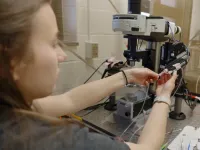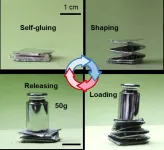(Press-News.org) UNIVERSITY PARK, Pa — Heavy alcohol consumption may cause permanent dysregulation of neurons, or brain cells, in adolescents, according to a new study in mice. The findings suggest that exposure to binge-levels of alcohol during adolescence, when the brain is still developing, lead to long-lasting changes in the brain’s ability to signal and communicate — potentially setting the stage for long-term behavioral changes and hinting towards the mechanisms of alcohol-induced cognitive changes in humans.
“What we’re seeing here,” said Nikki Crowley, assistant professor in biology and biomedical engineering and Huck Early Chair in Neurobiology and Neural Engineering, “is that if adolescent binge drinking knocks neurons off this trajectory, they might not be able to get back, even if the alcohol consumption stops.”
The prefrontal cortex is a key brain region for executive functioning, risk assessment and decision-making. According to Crowley, it’s not fully formed in adolescents and is still maturing in humans until around age 25. Disruptions to its development in young people may have serious and long-lasting consequences, added Crowley.
“Heavy binge drinking is problematic for everyone, and should be avoided, but adolescent brains appear to be particularly vulnerable to the consequences, which in humans, will follow them for decades,” Crowley said.
The team, led by Avery Sicher, a doctoral student in Penn State’s neuroscience program, used a model of adolescent ethanol exposure in mice to understand how different populations of neurons in the cortex, the outermost layer of the brain, are changed by voluntary binge alcohol consumption. In this model, mice are known to consume alcohol in patterns that approximate human binge drinking — defined by the National Institute on Alcohol Abuse and Alcoholism as a pattern of alcohol consumption that leads to a blood alcohol concentration of 0.08% or higher, usually in about two hours. Binge drinking is considered to be one of the most dangerous patterns of alcohol misuse, and understanding its impact on the developing brain can help inform treatment.
Sicher and her colleagues gave mice access to alcohol during a 30-day period. Due to their faster development and shorter lifespan, this corresponded to roughly ages 11-18 in human years. They then looked at the electrophysiological properties of different neurons throughout the prefrontal cortex to understand how adolescent binge drinking influenced the wiring and firing of these circuits. Sicher et al. used whole-cell patch clamp electrophysiology, combined with techniques such as optogenetics, which allowed the team to isolate individual neurons and record measurements related to intrinsic excitability, such as the resting membrane potential and the ability for each neuron to fire action potentials. This allowed them to understand how these neurons had changed their ability to signal with other neurons.
They found that somatostatin neurons, a key population of cells that provides inhibition of neurotransmitter release from other cell types throughout the brain and helps to “dampen the noise,” appeared to be permanently dysregulated in the mice that binge drank as compared to mice that were only provided water throughout development. Somatostatin neurons release both inhibitory neurotransmitters, like GABA, as well as inhibitory peptides like somatostatin, and proper functioning of these neurons is necessary for a healthy brain. The neurons were more excitable — meaning they were signaling too much and dampening the activity of other key neurons — as far out as 30 days after the mice stopped drinking alcohol, when the mice have transitioned into adulthood.
“Neurons have a relatively fixed developmental trajectory — they need to get where they are going and sync up with the right partners during specific periods of development in order to function properly,” explained Crowley.
David Starnes, an undergraduate biology student in Schreyer’s Honor College, performed somatostatin cell counts to quantify cell density before and after ethanol consumption. He found that while the electrophysiology data suggested these neurons wire differently, the number of SST neurons does not appear to change as a result of binge drinking.
Other authors on the paper include Keith Griffith, a research technician in the lab and former undergraduate in Engineering Science and Mechanics, Grace Smith, a graduate student in Biomedical Engineering, Dakota Brockway, a graduate student in neuroscience, and Nigel Dao, a former research technician in the lab and current doctoral student at New York University. This research was supported by the National Institutes of Health and the Huck Institutes of the Life Sciences at Penn State.
To learn more about Sicher’s neuroscience research, watch this short video from the Huck Institutes’ Student Spotlight series. The paper is currently available in the online version of the journal Neuropharmacology and will be published in the Aug. 15 issue.
END
Mouse models of adolescent binge drinking reveal key long-lasting brain changes
2023-06-09
ELSE PRESS RELEASES FROM THIS DATE:
Infants and toddlers up to 5 years old can participate in Shape Up! Keiki study at Pennington Biomedical
2023-06-09
The Pennington Biomedical Research Center is looking for children 5 years old and younger to participate in the Shape Up! Keiki research study. The purpose of the Shape Up! Keiki research study is to create a better way to measure and describe health from body shape.
“Parents can learn more about their child’s health by joining the Shape Up! Keiki study, while also providing important information that will help us find quick ways to measure obesity status and health based on a child’s body ...
Seenu Hariprasad named University of Chicago Chair of Ophthalmology and Visual Science
2023-06-09
Seenu M. Hariprasad, MD, the Shui-Chin Lee Professor of Ophthalmology, will be appointed Chair of the Department of Ophthalmology and Visual Science, effective July 1, 2023. He has been serving as Interim Chair since 2020.
Hariprasad is an internationally recognized vitreoretinal surgeon who originally joined the University of Chicago in 2005. Over the course of his career, he has developed a strong track record as a clinician, surgeon, researcher, educator, and leader in his department. He is a leading specialist in various vitreoretinal disorders, including macular degeneration, diabetic ...
Liquid metal sticks to surfaces without a binding agent
2023-06-09
Everyday materials such as paper and plastic could be transformed into electronic “smart devices” by using a simple new method to apply liquid metal to surfaces, according to scientists in Beijing, China. The study, published June 9 in the journal Cell Reports Physical Science, demonstrates a technique for applying a liquid metal coating to surfaces that do not easily bond with liquid metal. The approach is designed to work at a large scale and may have applications in wearable testing platforms, flexible devices, and soft robotics.
“Before, we thought that it was impossible for liquid metal ...
Estimated reductions in opioid overdose deaths with public health interventions
2023-06-09
About The Study: In this decision analytical model study of the opioid epidemic in four U.S. states, sustained implementation of interventions, including increased delivery of medications for opioid use disorder and naloxone supply, was found to be needed to reduce opioid-related overdose deaths and prevent deaths from increasing again.
Authors: Jagpreet Chhatwal, Ph.D., of Massachusetts General Hospital in Boston, is the corresponding author.
To access the embargoed study: Visit our For The Media website at this link https://media.jamanetwork.com/
(doi:10.1001/jamanetworkopen.2023.14925)
Editor’s Note: Please see ...
Racial, ethnic, sex differences in methadone-involved overdose deaths before, after federal policy change expanding take-home methadone doses
2023-06-09
About The Study: In this study of monthly methadone-involved overdose deaths, the take-home policy may have helped reduce deaths for Black and Hispanic men but had no association with deaths of Black or Hispanic women or white men or women. The urgency of the overdose crisis requires that national methadone policy debates and decisions address the heterogeneity of people in treatment; relaxing methadone restrictions may help some particularly at-risk groups.
Authors: Rebecca Arden Harris, M.D., M.Sc., of the University of Pennsylvania in Philadelphia, is the corresponding author.
To ...
Graphene-based Carbocatalysts: Synthesis, Properties, and Applications—Beyond Boundaries
2023-06-09
Introducing "Graphene-based Carbocatalysts: Synthesis, Properties, and Applications (Volume 2)"—a concise yet comprehensive compendium for the scientific community, professors, and students alike. This authoritative volume - published by Bentham Science - delves into the forefront of Graphene-based carbocatalysis, providing a wealth of factual knowledge and exploration. The book opens with an in-depth analysis of electrocatalysis by Graphene materials, unraveling the intricate relationship between Graphene and electrochemical reactions. It sheds light on the catalytic prowess exhibited by Graphene-based materials, offering promising avenues for advancing energy ...
Aston University wins £1.8m to boost West Midlands low carbon markets
2023-06-09
Aston University and local industry to develop technology to convert organic material into commercially valuable products
Sawdust, diseased trees and dried chicken litter among what can be transformed into sustainable bioproducts
West Midlands companies are invited to join a cluster to develop new low carbon products for growing markets.
Aston University is to receive £1.8 million to transform the West Midlands into a powerhouse of low-carbon product development and commercialisation.
The University will be building on its existing research facilities to lead the region’s Biochar CleanTech Accelerator as part of the West Midlands Innovation Accelerator.
The project ...
Price vs. health: Food shoppers choose price
2023-06-09
Key Takeaways:
When food consumers are properly incentivized, they will choose healthier options.
When financial incentives are removed, consumers are more likely to choose less healthy options by comparison.
BALTIMORE, MD, June 9, 2023 – A new study of food consumer shopping behaviors has found that when faced with a choice – lower prices or healthier foods – they will likely choose lower prices.
The study found that when you give food consumers temporary incentives to buy ...
Advances in eco-friendly gas insulating medium for next-generation SF6-free equipment
2023-06-09
Gas-insulated equipment (GIE) that utilizes the most potent greenhouse gas sulfur hexafluoride (SF6) as insulation and arc-quenching medium has been widely used in the power industry. Seeking eco-friendly insulating gas with advanced performance for next-generation SF6-free GIE is significant for the “net-zero” goal and sustainable development.
A research team led by Xiaoxing Zhang of Hubei University of Technology in China and scientists from Wuhan University, Southeast University, North China Electric Power University, Université de ...
BU/VA doc honored by the American Psychological Foundation
2023-06-09
(Boston)—Jillian C. Shipherd, PhD, a clinical research psychologist at the Women’s Health Sciences Division of the National Center for PTSD at VA Boston Healthcare System and a professor of psychiatry at Boston University Chobanian & Avedisian School of Medicine, has been selected to receive a 2023 American Psychological Foundation (APF) Gold Medal Award for Impact in Psychology. The award recognizes the work of a psychologist or group of psychologists that is impactful, innovative and transformational.
Additionally, Shipherd, along with Sarah E. Valentine, PhD, assistant professor psychiatry at the School, were honored with an Editor’s ...




